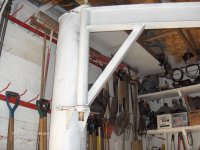jr37,
The web of an I-beam is the vertical connection from the top flange to the bottom flange if you are looking at the end of it. From the dimensions you gave me, there are two possible choices of I-beams: S4 X 7.7lb which would have a .193" thick web or a S4 X 9.5lb which would have a .326" thick web. Because I'm not certain which one you have, I used the specifications for a S4 X 7.7lb beam. This is a little lighter duty beam, but will error to the safe side.
From my calculations, 500lbs at the center would yield a deflection of .101".
at 1000lbs this increases linear to .202" of deflection. This is static loading. That just means what ever you lift is just hanging there. Now, if you start wrenching, pulling, yanking on the thing the load goes up, the deflection increases.
There are still a number of things to consider but without being too lengthy, I would not recommend lifting more than 750lbs. The gusset bars from the column to the legs might help reduce deflection but they also put a horizontal load (force) into the legs which could contribute to buckling.
Hope this helped some, but with any lifting structure, please be careful.



